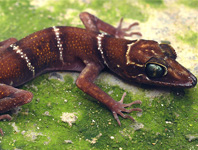Abstract
For the first time, the genus Bunops Birge, 1893 (Crustacea: Cladocera) has been found in the Neotropics of Mexico. It was found in only one pond in the Central Mexican Plateau, characterized by its high altitude, more than 2500 m above sea level. The specimens, corresponding to Bunops cf. serricaudata, are described here, including parthenogenetic and ephippial females, and males, using both morphological and molecular methods (DNA barcoding). The new micro-structural characters added here are: a detailed description of the internal part of valves in parthenogenetic females, the fine structure of all limbs, peculiarities of the ephippial female and males including new microcharacters of the first antenna and the hook on the first limb. We also include sequences of the COI mitochondrial gene (known as DNA barcode) and compare them with other macrotricids. With this new information, we hope to understand further this enigmatic and elusive genus and facilitate future research and comparisons at the global level.
References
Banta, A. (1925) A thelytokous race of Cladocera in which pseudo-sexual reproduction occurs. Zeitschrift fuer Induktive Abstammungs und Vererbungslehre Berlin, 40, 28–41.
https://doi.org/10.1007/bf01740943Birge, E.A. (1893) Notes on Cladocera III. Transactions of the Wisconsin Academy of Sciences, Arts and Letters, 9, 275–317.
Davidson, N.L., Griffin, M.C. & Kelso, W.E. (1997) A report of Bunops scutifrons from Louisiana. Hydrobiologia, 356, 183–184.
https://doi.org/10.1023/a:1003175113548Dedjar, E. (1927) Zur Biologie von Bunops serricaudata (Daday). Zoologischer Anzeiger, 70, 100–104.
Elías-Gutiérrez, M., Smirnov, N.N., Suárez-Morales, E. & Dimas-Flores, N. (2001) New and little known cladocerans (Crustacea , Anomopoda) from southeastern Mexico. Hydrobiologia, 442, 41–54.
https://doi.org/10.1023/a:1017506804840Elías-Gutiérrez, M., Martínez-Jerónimo F., Ivanova N.V., Valdez-Moreno, M. & Hebert, P.D.N. (2008) DNA barcodes for Cladocera and Copepoda from Mexico and Guatemala, highlights and new discoveries. Zootaxa, 1849, 1–42.
Folmer, O., Black, M., Hoeh, W., Lutz, R. & Vrijenhoek, R. (1994) DNA primers for amplification of mitochondrial cytochrome c oxidase subunit I from diverse metazoan invertebrates. Molecular Marine Biology and Biotechnology, 3, 294–299.
Flössner, D. (1972) Krebstiere, Crustacea, Kiemen-und Blattfüsser, Branchiopoda, Fischläuse, Branchiura. VEB Gustav Fischer Verlag, Jena, 501 pp.
Garfias-Espejo, T. & Elías-Gutiérrez M. (2003) Taxonomy and distribution of Macrothricidae (Crustacea: Anomopoda) in southeastern Mexico, northern Guatemala and Belize. Anales del Instituto de Biología, 74, 105–134.
Hebert, P.D.N., Witt, J.D.S. & Adamowicz, S.J. (2003) Phylogeographical patterning in Daphnia ambigua: Regional divergence and intercontinental cohesion. Limnology and Oceanography, 48, 261–268.
https://doi.org/10.4319/lo.2003.48.1.0261Hajibabaei, M., DeWaard, J.R., Ivanova, N.V., Ratnasingham, S., Dooh, R., Kirk, S.L., Mackie, P.M. & Hebert, P.D.N. (2005) Critical factors for assembling a high volume of DNA barcodes. Philosophical Transactions of the Royal Society of London Series B-Biological Sciences, 360, 1959–1967.
https://doi.org/10.1098/rstb.2005.1727Hudec, I. (2010) Anomopoda, Ctenopoda, Haplopoda, Onychopoda (Crustacea: Branchiopoda). Fauna Slovenska Slovak Academy of Sciences, Bratislava, 499 pp.
Kimura, M. (1980) A simple method of estimating evolutionary rate of base substitutions through comparative studies. Journal of Molecular Evolution, 16, 111–120.
https://doi.org/10.1007/bf01731581
Kotov, A.A., Korovchinsky, N.M. & Petrusek, A. (2013) World checklist of freshwater Cladocera species. Available from: http://fada.biodiversity.be/group/show/17 (accessed 17 July 2017)
Kumar, S., Stecher, G. & Tamura, K. (2016) MEGA7: Molecular Evolutionary Genetics Analysis Version 7.0 for Bigger Datasets. Molecular Biology and Evolution, 33, 1870–1874.
https://doi.org/10.1093/molbev/msw054
Merrill, H.B. (1893) The structure and affinities of Bunops scutifrons, Birge. Transactions of the Wisconsin Academy of Sciences, Arts and Letters, 9, 319–342.
Montero-Pau, J., Gomez, A. & Munoz, J. (2008) Application of an inexpensive and high-throughput genomic DNA extraction method for the molecular ecology of zooplanktonic diapausing eggs. Limnology and Oceanography, 6, 218–222.
https://doi.org/10.4319/lom.2008.6.218
Prosser, S., Martínez-Arce, A. & Elías-Gutiérrez, M. (2013) A new set of primers and some methodological improvements for COI amplification in freshwater microcrustaceans. Molecular Ecology Resources, 13, 1151–1155.
https://doi.org/10.1111/1755-0998.12132
Ratnasingham, S. & Hebert, P.D.N. (2007) BOLD: The Barcode of Life Data System (www.barcodinglife.org). Molecular Ecology Notes, 7, 355–364.
https://doi.org/10.1111/j.1471-8286.2007.01678.x
Silva-Briano, M. & Dumont, H.J. (2001) Wlassicsia, Bunops & Onchobunops (Anomopoda), three related genera. Hydrobiologia, 442, 1–28.
https://doi.org/10.1023/A:1017502703931
Smirnov, N.N. (1992) The Macrothricidae of the world. SPB Academic Publishing, Amsterdam, 143 pp.
Vázquez, M.A., Solis, M.E., Rebollo, C.L. & Suárez-Morales, E. (1988) Significado de la alta densidad de cladóceros en ecosistemas sujetos a un ingreso de nutrientes elevado. Universidad Juárez Autónoma de Tabasco y Sociedad Mexicana de Zoología, 1998, 199–206.

